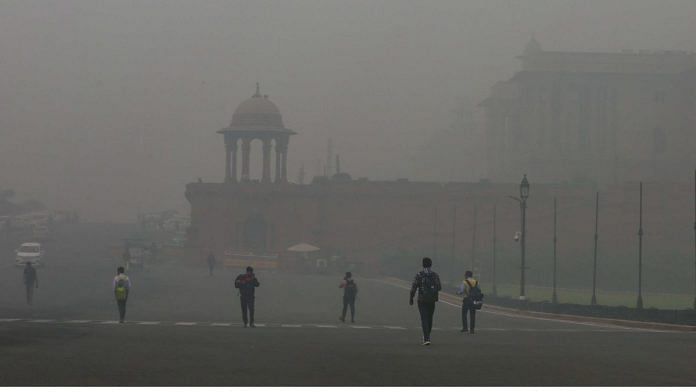New Delhi: Delhi’s air pollution forecasting system could accurately predict only five out of 14 severe air quality days in the winter of 2024-2025, according to a new report by the Council on Energy, Environment and Water (CEEW), a non-profit research organisation. The study, titled How Well can Delhi Predict Air Quality? and released Wednesday, looked at Delhi pollution days anticipation mechanism in anticipation of the pollution days in the coming months.
The Central Pollution Control Board and its sensors are responsible for measuring pollution and smog levels in India. However, back in 2018, the Union Ministry of Earth Sciences had come out with the Air Quality Early Warning System (AQEWS) and Decision Support System (DSS), which used historical air quality data, wind speed and other information to predict air quality, at least three to five days in advance. Additionally, the DSS also gave information about how much each source is contributing to pollution.
It is this prediction that city authorities are supposed to use to impose air pollution action plans, such as the Graded Response Action Plan (GRAP) in Delhi NCR.
But the CEEW study found that all GRAP-III and GRAP-IV implementations in Delhi last winter were based on observed AQI (Air Quality Index) levels, rather than forecasted levels. This diminishes the value of both the forecasting system and the GRAP measures, which are meant to be preemptive actions.
“Eight Indian cities, including Ahmedabad, Pune, and Jaipur, already run an Air Quality Early Warning System (AQEWS), with several more set to be established under the National Clean Air Programme (NCAP) in the coming years,” reads the report.
The study critically analysed the efficiency of Delhi’s air pollution forecasting methods, both in a qualitative and quantitative manner.
Qualitatively, Delhi’s air quality forecasting system has everything in place—it uses a variety of data, such as historical air quality, satellite data of farm fires, and weather data. “We observe that the AQEWS and DSS align well with most characteristics of an ideal (air quality decision support system),” says the report.
Through quantitative analysis, the researchers found that the system could predict days of ‘very poor’ air quality (more than 300 AQI) with 80 percent accuracy. Last winter, AQEWS accurately predicted 83 out of 92 days of very poor air quality.
But the number dipped, when it came to severe air quality days. In terms of severe (more than 400 AQI) air quality, the system could accurately predict just five out of 14 days. Even this, according to the study, was an improvement from last year, when it could only predict one out of 14 such days. The study also found that both during summer and winter months, the AQEWS underpredicted the PM10 and PM2.5 levels in the air.
“Reliable air quality forecasts can play a crucial role in informing citizens of the precautionary measures they should adopt to protect themselves from exposure to polluted air,” said Sneha Maria Ignatious, programme associate at CEEW and co-author of the study, in a press statement. “While Delhi has a fairly reliable system providing air quality forecasts, there is a need to strengthen it further.”

Also Read: Healing ozone may recover to 1980s level in 25 years, but monitoring still critical—WMO report
Challenges and suggestions
The study observed that while Delhi’s AQEWS could be comparable to an ideal forecasting system globally, it is not doing enough just yet.
While it does have a section for GRAP implementation in its forecasts, the system was not monitoring the outcomes of these GRAP measures. Any ideal AQEWS system, according to the CEEW study, beyond forecasting air pollution, also needs to “monitor the outcomes” of the government interventions implemented to act on it.
Another thing that the CEEW report brought up is the connection between AQI forecasting and GRAP measures. It was observed that despite it being proactive, GRAP was only enforced retrospectively in Delhi after the air quality had already breached the required stage.
In connection with that, the researchers put forward suggestions to improve the current system. For instance, the study suggests that the DSS should have a way of determining which neighbouring districts contribute to pollution in which sector. While we currently do have information about pollution from 19 adjoining districts, the study said it would be better for policy interventions to have more accurate information.
Another major suggestion in the study is to keep updating the emissions inventory, which is the list of sources and kinds of emissions that are monitored. Currently, Delhi uses an inventory made in 2016, while countries like UK, China and even Mexico update their inventories every two-three years. This would help in both policy and health level interventions—for people to understand what the most common and most harmful emissions found in their city’s air are.
(Edited by Mannat Chugh)






